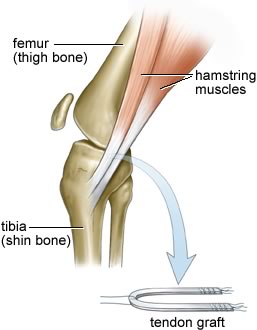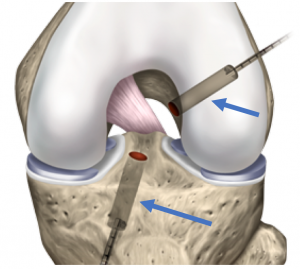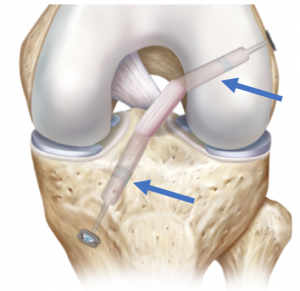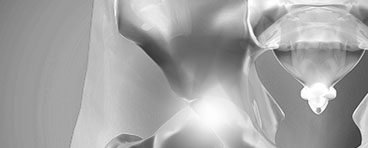Click on the links below to find out more
OVERVIEW
ACL reconstruction is a safe and effective operation to get you back on your feet again, keeping fit and enjoying the sports you love. Are you suffering from an anterior cruciate ligament (ACL) injury? You’re not alone. Thousands of people experience this injury every year.
The ACL connects the thigh bone to the shinbone and is one of the key ligaments that help stabilize the knee joint. It’s usually torn during sudden stops and changes of direction, particularly in sports such as soccer, tennis, basketball and volleyball. This kind of injury may also be accompanied by a meniscal tear.
Get Back on Your Feet with ACL Reconstruction Surgery in Melbourne
If you’ve torn your ACL, you probably felt immediate pain and a ‘pop’ in your knee. Even if the swelling has reduced, your knee may still feel relatively unstable and may even ‘give way’ as you walk. Often, the most effect solution for an ACL injury is to have ACL reconstruction surgery, although it is possible to heal an ACL injury without surgical intervention.
What is ACL Reconstruction Surgery?
ACL reconstruction surgery is a safe and effective procedure that involves taking a tendon graft from one part of your body and inserting it into your knee. Once in place, it will function as an anterior cruciate ligament.
Where do the tendons come from?
Various tissues are routinely used for ACL surgery including hamstring tendons, patella tendons, quadriceps tendons, cadaver tendons and synthetic tendons.
What are the risks?
As with any surgical procedure, there are risks attached. However, arthroscopic ACL reconstruction is generally a low-risk operation with excellent clinical outcomes. There are, of course, some potential risks and these include re-rupture of the ligament, stiffness, infection, pain and residual laxity or instability.
ACL Surgery in Melbourne by Dr David Slattery
Although Dr David Slattery is skilled and experienced in many different types of tendon grafts, for routine reconstructions, he prefers to use hamstring tendons. He finds that this graft offers excellent strength, a very low rate of complications and excellent long-term results. The surgery is carried out using an Arthroscope which means he can use smaller keyhole incisions during the reconstruction and while securing the graft in place. The same technique will be used to harvest the tendon graft.
During your consultation, Dr David Slattery will explain the procedure in more detail and cover the potential risks. He prefers to take a patient-centric approach to all his surgeries; he’ll ensure you’re fully informed about procedures, risks and outcomes before you make any decisions and will always keep communication open and honest. He believes that you should always have the opportunity to take an active part in the discussion about your care.
Over the years working as a orthopedic surgeon in Melbourne, Dr David Slattery has treated many patients with ACL tears, including professional athletes, elite sports people and international cricketers. With his technical and surgical skills, you’ll be back on your feet and playing the sport you love as soon as possible.
Whether you have private medical insurance or need a quote for ACL surgery in Melbourne, we can help, and you can find the costs of consultation and surgery here. Dr David Slattery is also happy to see you if you require a second opinion.
Not Just an ACL Surgeon in Melbourne
One reason why Dr Slattery is a renowned ACL Surgeon in Melbourne is down to his unwavering commitment to excellence. He is constantly looking for ways to improve his skills, learn new techniques and pass on his wealth of experience to newly qualified practitioners. He’s taken on the role of teacher for medical students, registrars and junior doctors and is engaged in an ongoing program of research into hip and knee disorders.
At the heart of his research are past and present patients and he’s extremely grateful for their participation as it gives him and the wider orthopaedic community the opportunity to better understand and plan treatments for a range of orthopaedic conditions. His findings and experiences are often used as the basis of medical papers for a variety of journals. By sharing such information, it can help improve the work of ACL surgeons in Melbourne and further afield.
In addition to his ACL reconstruction surgery, Dr Slattery also carries out a range of orthopaedic surgery including hip and knee replacements. So, as you can see, he’s more than just a renowned ACL surgeon in Melbourne, he’s an orthopaedic specialist.
To arrange a consultation, contact Dr David Slattery via the online booking form or at one of the rooms where he is currently consulting. Dr David Slattery also provides other knee treatments such as knee arthroscopic surgery, hip treatments such as arthroscopy hip surgery and robotic hip replacement. Alternatively, if you need help outside of normal surgery hours call 1300 266 356.
ACL reconstruction surgery involves taking a tendon graft from one part of your body and inserting it into your knee to function as an ACL. There are various tissues that are routinely used for ACL Grafts, there are pros and cons of each, but options are:
- Hamstring Tendons (Gracilis and Semi-Tendinosus Tendons)
- Patella Tendon
- Quadriceps Tendon
- Cadaver Tendons
- Synthetic Tendons
Dr Slattery has used many different types of grafts, and different types of grafts suit different patients. For routine reconstructions he prefers using Hamstrings Grafts due to a very low rate of complications, excellent strength, and terrific long term results.
Over time, the hamstring tendons regenerate.
Procedure
Anaesthetic
The surgery is typically performed under general anaesthetic with the use of local anaesthetic blocks and infiltration to reduce the need for opiates and strong pain relief which can slow down recovery. This can be discussed with your anaesthetist prior to your operation.
Incisions
Dr Slattery performs Arthroscopic ACL reconstructive Surgery. This means that he only need to utilise small keyhole incisions to reconstruct your ACL. There are two other small incisions that are needed to harvest the tendon graft, and to secure the graft in place. These are closed with dissolving stitches to reduce discomfort and scarring.

Above: Pen indicates regenerated Hamstrings tendon
Technique
The knee is thoroughly inspected by knee arthroscopy initially to assess for associated knee injuries, such as meniscal tears which can occur in up to 60% of patients. These may require treatment at the same time as ACL reconstruction.
The ACL is assessed and the knee is prepared for reconstruction. Two bone tunnels are drilled in the femur and the tibia in an anatomic location to accept the new graft. Tunnel placement is critical for graft survival and ACL function.
The graft is then passed through the tunnels and secured with fixation in the tibia and femur to allow the graft to integrate. There are various types of fixation available and each have advantages and disadvantages, common techniques are buttons, screws and staples. These are normally visible on post operative X rays.
Associated Procedures
In some cases it may be necessary to do other ligament reconstruction procedures to give the knee additional stability, an example of this would be an anterolateral ligament reconstruction (ALL). This has increased in popularity recently to control rotation in high demand and heavier patients. This requires an additional incision and involves taking a strip of tissue from the outside of the knee (ITB) to recreate the anterolateral ligament.
If there is an associated meniscal tear, this may require repair at the time of ACL recontruction, and additional incisions may be required depending upon the type of tear and its location.

Above: bone tunnels for ACL reconstruction shown by blue arrows (Arthex)








